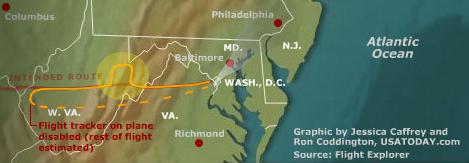
Reproduced from "The Guardian"
AMERICAN AIRLINES FLIGHT 77.
8:20 am : Flight 77 departs from Dulles
Airport. Some 20 miles from the Pentagon.
8:50 : Last radio communication with
flight 77. Now some 280 miles from the
Pentagon.
8:56 : Transponder contact lost. Now some 335
miles from the Pentagon.
9:00 : Flight 77 turns and heads for the
Pentagon (Washington DC). Now some 370
miles away from the Pentagon.
The hijackers finally make their move (and about time, all the time they are
getting further and further away from where they started, and of course, further
and further away from where they are headed).
To give the Air National Guard/USAF a fighting chance the intrepid hijackers
wait till they are about 400 miles away from their target before turning back.
But even though the hijackers are more than sporting about the whole affair
(after all they have given the USAF over 40 minutes to get aircraft up to
investigate, and if necessary, shoot them down) the totally incompetent (read
corrupt) USAF isn't quite up to the job.
9:37 : AA77 crashes into the southwest
side of the Pentagon. Now, precisely 0
miles from the Pentagon.
The question that you must ask yourself, is :
Why didn't the hijackers, hijack flight 77 when it was
only, say, 30 miles from the Pentagon?
The flight path of flight-77 is shown in the following graphic :

which was copied from here.
DID A BOEING 757 HIT THE PENTAGON.
The official line regarding flight 77 (a Boeing 757) is that terrorists hijacked
it, flew it about the countryside for 40 minutes (during which time, not
one of the fighter jets from any of the numerous nearby US Air Force and Air
National Guard bases were sent up to investigate) and then crashed it into
the Pentagon.
Recently, there has been some speculation that flight 77 never existed and that
the damage to the Pentagon had some other cause. The main statements supporting
this idea are:
We wish to investigate the
plausibility of these arguments. In doing this, we mention that the paucity of
information from the Bush administration, has certainly not helped (for example,
the Bush administration has refused to release the black boxes, the voice
recorders, or even pictures of any wreckage). However, the military did release
a number of high resolution photos on the websites:
Defense
Link Photos.
Joint
Combat Camera Center - Pentagon Attack.
So, first, we investigate exactly how big the hole in the Pentagon was.
The main problem in estimating its size, is the fact that the section of the
building that was struck collapsed about 30 minutes after the impact. I have
been able to find three pre-collapse photos. They are presented below, each
immediately followed by a graphic displaying in red,
the area of the Pentagon wall visibly NOT demolished
by the impact.
|
|
|


|
|
|
To complete the scene we need to know the areas still not demolished after the
collapse.

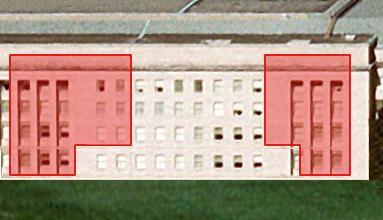
Now combining all the sections together we obtain the following :

All that remains to be done is to add in a Boeing 757 :

Nearly there, however the wings still do not fit the (maximum) impact hole size.
Even just a wing tip, traveling at speed, would do considerable damage to the
Pentagon wall. The explanation for this, is (probably) that when the nose hit
the wall, the wings would have continued on, pivoting momentarily about the wing
base, until they snapped off. This momentary pivoting of the wings (like
extended hands coming together in prayer) may be enough to explain why the last
12 (or so) feet of the wings did not impact the wall.
Well, I wrote the last paragraph when I believed that the plane must have hit
the Pentagon nearly square on. However, a couple of photos (shown below) made it
crystal clear that the aircraft hit the Pentagon at about 45 degrees to the
wall. This changes everything, as the apparent wing span increases hugely, as
illustrated here:

So the 125 feet wingspan of the Boeing 757 would (give or take a bit for the
wings snapping off) have made a hole, about 177 feet wide, in the Pentagon wall.
This clearly did not happen.
So, I think it is safe to say that although the hole in
the Pentagon wall appears to have been made by an aircraft, it is in fact, too
small, to have been made by a Boeing 757.
So what about the second statement. Is the overall damage to the Pentagon as
extensive as one would expect from such a crash?
Well, the entry wound seems to have been made by an aircraft. How about the exit
wound. One would expect both the fuselage and jet engines to penetrate quite a
number of the inner walls.
Strangely, certain sections of the media have been trying to convince the world,
that the major impact damage was restricted to the outer ring (the E-ring). To
justify this wild claim they state that:
These, and the fact that the aircraft hit obliquely (at a 45 degree angle to the wall) are meant to convince us, that the major impact damage was restricted to the outer ring. I claim that all three of these statements are wrong. Their claim is a joke, nobody believes that a Boeing 757-200 weighing nearly 100 tons and traveling at an estimated 300 miles an hour, only damaged the outer ring of the Pentagon. To make their case the media present graphics like the following:
|
|
|
These graphics purport to show the damage to the concrete structural columns.
Note, that in the media version of events, the major structural damage is
clearly limited to the E-ring. Actually, the C, D and E-rings are presented as
one unit and the collapsed area is wrongly outlined in both of these graphics.
This is a example of deliberate deception which, if necessary, can be explained
away as a simple mistake. Two examples of such spin are:
http://www.ArchitectureWeek.com/2001/1003/news_1-2.html
http://www.washingtonpost.com/wp-srv/nation/graphics/attack/pentagon_7.html
To further their case, they produce the following picture of the northern
section of the alcove between the E and D-rings:

which shows no major structural damage beyond the E-ring. The collapsed area of
the Pentagon is to your left. Except for the V-shaped nick (that you can see in
the upper left corner of the photo) the back wall of the collapsed area remained
standing even though the front collapsed.
Now, how do we reconcile the media view, with the following photo of a large
exit wound made by the aircraft exiting C-ring (remember C-ring is the third
ring in (from the outside)):

This photo is of the inside wall of the C-ring. This is the hole caused by the
aircraft exiting C-ring. Of course, for the aircraft to be exiting C-ring, it
must have already exited both the D-ring and E-ring. Its caption originally
read:
"A Military District Washington engineer
firefighter stands in front of the exit hole where American Airlines Flight 77
finally stopped after penetrating the Pentagon."
The nearly circular hole is about 12-feet wide and was later said to have been
caused by one of the jet engines. I do not believe this. I believe the fuselage
is much more likely to have caused the damage here (as it was first reported).
In fact, it is probable that after being stripped of most of the fuel, the
fuselage survived more or less intact (albeit, somewhat shorter). Perhaps, this
is the real reason that the Bush administration has not released any photos of
it, or allowed independent access to it. Perhaps, the recent rush to convince
the world that the Pentagon damage was inflicted by a smaller plane (or
something other than a plane) is part of an attempt to hide information that
might come out if the public thought there was wreckage to see, and demanded to
see it.
Although, the most likely reason is simply that the
wreckage is not that of a Boeing 757.
Lets work on reconciling the last two photos first. Summarizing :
Initially, I thought that this implied that the exit wound in E-ring must be in the southern section of the alcove and therefore that the aircraft did not hit the Pentagon at the reported 45 degree angle. However, I came across these photos of the exit wound:

which makes it very clear that the aircraft did in fact hit the Pentagon at
about a 45 degree angle.

The exit wound is visible within the red boxes. Many thanks to Geoff Metcalf for
providing these photos. Larger, higher resolution versions of these photos can
be found at Geoff's website:
http://www.geoffmetcalf.com/pentagon/images/16.jpg
http://www.geoffmetcalf.com/pentagon/images/17.jpg
The above puzzle is solved by noticing that only three rows of windows are
visible in the photo of the alcove (Have a look. Also look at the photo
immediately above. Notice that, five floors are visible between the B and
C-rings, but that only three floors are visible between the C and D-rings).
Since the Pentagon has five floors, what we are seeing in the alcove, is not the
ground, but the roof of two floors of offices which span the gap between the E
and D-ring. Since the aircraft first hit the concrete slab that formed the
ceiling of the ground floor, it would have smashed its way through the building
at ground level until it came to a stop. Since all the damage would have been at
ground level, it would have been well below the second floor roof, and we would
not expect the damage to be seen in the above photo of the alcove.
By the way, here is the official Pentagon view. Note the wording : Wedge 1
E-ring to Wedge 2 C-ring. This is referring to the structural damage. Note also,
that this very different from the media view.
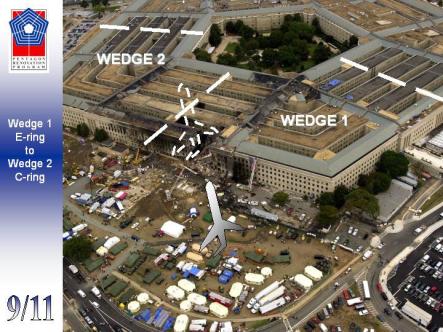
It is also claimed that the Pentagon walls were specially reinforced. However,
the outer Pentagon wall comprised a framework (grid) of 10 inch reinforced
concrete members with the intervening space filed with 8 inch thick brickwork.
Over this was placed about 6 inches of decorative granite. So, the (outer) wall
was at most, 16 inches thick, and was not particularly strong (contrary to media
reports). The following photos show this to be the case.

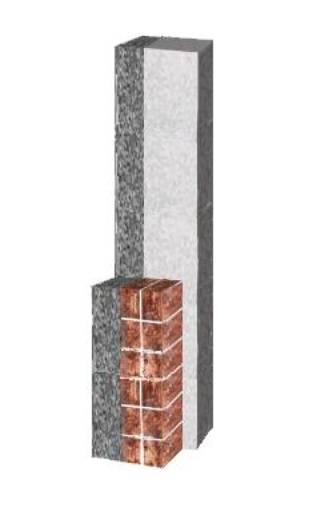

Look at the third photo. Notice that the floor slab of the second floor (the
ceiling of the first floor) has been ripped apart. This is where the aircraft
(the wing tip) first hit the wall. I mention this here for later, as it shows
that the aircraft did not hit the ground before hitting the wall.
So, the Pentagon's walls were not particularly strong (media talk, that the
outer wall had recently been made blast-resistant, is apparently correct, but
essentially irrelevant, as blast-resistant does not in any way imply hardened)
and it was to be expected that the plane penetrated deep into the building. That
the damage to the inner rings was extensive is also given credence by the fact
that the first three rings of the Pentagon were demolished for reconstruction,
however, the fire only damaged the outer ring and two of the "spokes",
as shown in these photos from www.spaceimaging.com.
|
|
|
The strange insistence by the media, that the damage is minimal, is very
puzzling, and one would have to guess that the media is just spreading
disinformation to muddy the waters, so that the correct questions and answers
get lost in the confusion.
Overall, though, the damage to the Pentagon is about as
extensive as one would expect from the crash of a large aircraft, that was a bit
smaller than a Boeing 757.
So, on to the third statement : No Boeing 757 debris has been recovered from the
site.
Well, what has been released to the public so far.
|
|
|
Yes, that's it. That is the evidence so far. Very far from satisfying. The
second picture probably shows part of the helicopter, that eye-witness, Lincoln
Liebner, reported was struck by the aircraft before it hit the Pentagon. It is
much too far in front of the Pentagon wall to be wreckage from the aircraft that
hit the Pentagon (in fact, nothing in front of the Pentagon wall will be
wreckage from that aircraft).
So, what of the reports that there are pictures of a huge stack of plane
wreckage heaped just outside the Pentagon. There are two high resolution photos
which show this heap of debris.

When we enlarge the area within the red box (lower left corner) we obtain :

This is certainly not aircraft debris. The second photo gives a complete view of
the heap of debris.

When the boxed area is enlarged, we do not obtain such a clear picture. The area
described by the first detailed photo of the debris heap (which was taken from a
different angle) is that within the red outline in the photo below (both of the
photos from which the enlargements were made were taken at about the same time).

Note the angular nature of the debris. This angular nature makes it unlikely
that the rest of the debris heap contains any aircraft wreckage either.
So, the third statement is correct. The public has
absolutely no evidence, that Boeing 757 debris has been recovered from the site.
We do not know if the FAA or military has any Boeing 757 wreckage stored away.
If this is the case, then the Bush administration must allow independent
investigators access to it. Until then, we must assume that no such wreckage
exists.
It is clear that, the Bush administration, could remove all speculation by
releasing the wreckage of flight 77 to independent investigators. The fact that
it has not done so, is very puzzling and also, very suspicious.
Overall though, I feel that there is considerable evidence that :
The evidence that an aircraft hit the Pentagon, includes among other things :
The evidence that this aircraft was not a Boeing 757, includes among other things :
Of course, the big question
is :
If flight 77 did not hit the Pentagon, then where is it,
and its passengers?
The article The
Flight of the Bumble Planes deals with this question. What do you think?
EXPLOSION AT THE PENTAGON.
Photos show moment hijacked airliner hit the Pentagon.
A sequence of government photos shows the moment
the hijacked American Airlines plane crashed into the Pentagon on September 11.
The photos were taken by a surveillance camera positioned north of the section
of the Pentagon destroyed by the impact and the resulting explosion and fire.
The images cover a span of four one-hundredths of a second.
The first photo shows a small, blurry white object near the upper right corner -
possibly the plane just a few feet above the ground.
The second shows a white glow immediately after the impact. In the other photos,
a mountain of orange fire and black smoke rises above the building.
The photographs were not officially released by the Pentagon, but officials said
the images were authentic and had been provided to law enforcement officials
investigating the attack. Officials could not immediately explain why the date
typed near the bottom of each photograph is September 12 and the time is written
as 5.37pm The attack happened at about 9.37am the previous day. Officials said
it was possible that the date and time were added the day after the attack when
they may have been catalogued for investigative purposes.
Story filed: 04:18 Friday 8th March 2002.
So, let's have a look at these photos.
Notice that all the following pictures support the wrong
date and time (of course, the event in question occurred on September 11,
2001 at about 9:37 a.m.).
|
|
|
Notice that, both of these pictures (which quite clearly did not occur at the
same time) have the same (wrong) time stamp.
Notice that, in the "impact" picture, the intense light source of the
explosion does not cast any shadows of its own. In particular, the
parking control structure does not have a (fainter) second shadow.
Notice also that in the "impact" picture, the Pentagon wall is much
brighter than in the other photos. The forger seems to have realized that the
explosion would light up the entire Pentagon wall (but overlooked the fact that
it would cast shadows of its own). He has tried to imitate the flash of the
blast by increasing the brightness of the entire picture, unfortunately for him,
this also increased the brightness of the areas that
should still be in shadow (and thus darker). For example, the sides of
the parking control structures facing the camera have also increased in
brightness.
|
|
|
In the photo labeled "plane" we are meant to be able to see the tail
of the Boeing 757 just above the larger of the parking control structures. As
has been pointed out by many, this is either the tail of a much smaller plane,
or a complete fabrication (the second being my belief). If this were the tail of
a Boeing 757, then you would have actually seen, something like the photo on the
right (for a little on how the size of the aircraft was calculated, click
here).
|
|
|
Notice that, the "impact" picture has clearly
been touched up. Notice that, the green tinge on the left has been partly
(and amateurishly) erased and that the top left corner has probably been erased.
These areas have been outlined in blue. It is possible that the effect in the
top left corner is due to over exposure, caused by the sun, but then, why is
this effect not visible in the photos taken just before and just after this one.
Another complaint is that the camera housing is clearly visible in the top left
and right corners of this photo, yet is not visible in any other of the pictures
of exactly the same scene, taken by the same camera, from the same fixed
location.
Notice that, in all the photos the shadows have been
enhanced. This is particularly noticeable for the shadow of the parking
control structure and its lights. This shadow has been outlined above in magenta
and is enlarged below to illustrate the shadow's shadow.

Real shadows just don't come with their own outline. More evidence that the
pictures have been touched up.
Notice that, the heliport control tower (the area outlined above in red) is
engulfed in the fireball. This must be so, since it appears red. Otherwise, it
would be in shadow and appear black. The forger seems to have forgotten that the
close (to the camera) end of the heliport control tower is a long way from the
impact site. One can clearly see that the fireball
engulfs the heliport control tower, in the following enlargement.

Notice that, in the remaining photos the fireball has increased in size, but somehow
it has managed to shrink back behind the heliport control tower, and
leave it in shadow.
|
|
|
The pictures exhibit a few physical impossibilities. As an example, consider the
"impact 2" photo. We are interested in determining the size and
position of the fireball. We draw lines (along the ground) from the camera to
both sides of the heliport control tower and also, both sides of the part of the
fireball that is in front of the Pentagon wall. We then measure the 3 angles.
From left to right they are 6, 6 and 8 degrees.

Now, imagine that the lines in this photo have been painted on the ground. Then
they would appear in other photos of the scene. In all such photos, the ratio of
the sizes of the angles between the lines will remain the same, namely, 6:6:8.
Knowing this will allow us to estimate the size/extent of the fireball.
We proceed to mark these lines on the following photo. First, we draw the two
lines that bound the heliport control tower. To do this, it is necessary to
estimate the position of the base of the heliport control tower. I have marked
the base of the tower in magenta. Now we measure the angle between these lines.
It is 4.5 degrees. To keep the 6:6:8 ratio, the angles must be 4.5, 4.5 and 6
degrees, respectively. To get the line that bounds the back of the fireball, we
measure 6 degrees toward the left side of the photo and draw a line. To get the
line that bounds the left (left as in the "impact 2" photo) edge of
the part of the fireball that is in front of the Pentagon wall, we measure 4.5
degrees toward the right side of the photo and draw another line. Having done
this we obtain the four white lines illustrated. These are the lines we would
see if we had painted the lines in the "impact 2" photo, on the
ground.
To make sure we all know the positions of the points of interest, note that the
white lines emanate from the security guard's booth, where the security camera
is housed, the heliport control tower is the building whose base has been marked
in magenta and that the point of impact (center of the explosion) has been
marked with a small red dot.
We now wish to mark the area covered by the explosion. The center of the
explosion will be approximately the point of impact of the nose of the aircraft.
At the time that the "impact 2" photo was taken, the maximum distance
that the fireball would have extended from the center, will be in the direction
directly away from the wall, and will be bounded by the leftmost white line.
This allows us to mark out the maximum (physically possible) area covered by the
fireball at the time the photo was taken. I have marked this area with a red
semicircle. Remember, that this circle represents the maximum area covered by
the fireball (at least the part of it that was in front of the Pentagon) at the
time that the "impact 2" photo was taken.

The portion of the fireball visible in section B of the "impact 2"
photo, must be located within the red semicircle and between the leftmost 2
lines.
The portion of the fireball visible in section A of the "impact 2"
photo, must be located within the "slice of pie" shaped area that
projects out of the semicircular region.
But how can this be? The "slice of pie" shaped region is a long way
outside the maximum physically possible extent of the fireball. Unfortunately
for the forger, there is no explosion in this region. He has made the same
mistake as he did in the "impact" photo, he has assumed that the
heliport control tower is much closer to the point of impact, than it actually
is. Although his forgery looks good in 2 dimensions, when considered in 3
dimensions, it is clearly impossible.
One may object to the fact that the initial velocity (speed) of the fuel has not
been considered. The fuel was traveling at about 300 miles per hour when the
explosion occurred. Since the aircraft hit the wall at (about) 45 degrees, the
velocity of the fuel parallel to the wall was 300 / 1.414 = 212 miles per hour =
312 feet per second. So, any fuel that did not enter the building, would have
traveled 312 feet along the wall, every second. We have been told that in the
"impact 2" photo, the explosion is 2-hundredths of a second old. Hence
the whole fireball will have traveled 312 x 0.02 = 6.24 feet (along the wall)
from the point of impact. This is such a small distance (compared to the
expansion due to the explosion) that we can safely ignore it.
It takes a little effort to see this, but it is worth the effort. In summary,
the "impact 2" photo shows a section of fireball in an area where
there was no fireball.
Because I had to guess at the position of the base of the heliport control
tower, I repeated the process with an overhead view in which all the relevant
points were clearly visible. This gives a slightly more accurate picture.

The last photo of the series is :

Note that the time interval between the beginning and end of the
"explosion" is said to be 4 one-hundredths of a second. This is
clearly garbage. They are claiming that a Pentagon security camera is taking one
hundred frames (pictures) per second. I have immense trouble not laughing
at these people.
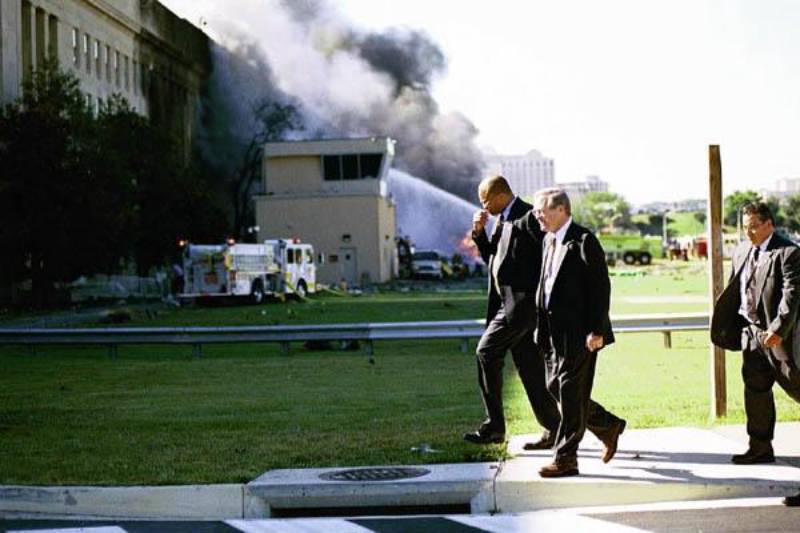
Compare the above security camera photos with this one taken with a 35mm camera
(from close to the booth containing the security camera) of the very same scene.
Notice that the security camera is a high quality camera that can take one
hundred frames per second, but that it takes very low quality photos. In fact,
the quality is so low that the wooden post that you can see to the right in the
above photo, is next to invisible in the security camera shots.
In conclusion. This has to be the most shoddy piece of
forgery ever. Virtually nothing, has been done correctly. In fact, these
photos are such a hash job, that I suspect the person who faked them sent the
wrong files to the press (leaving a very lonely final edition on his hard
drive).
Just in case you are not yet convinced. Lets consider another physical
impossibility :
The crash here, is not like the usual air crash, where the plane hits the
ground, the fuel tanks rupture and the fuel spills along the ground at high
speed, mixing thoroughly with the air and exploding outward and upward.
Here, most of the fuel spills into a confined space with little opportunity to
mix thoroughly with air (oxygen). Hence, the explosion will be much smaller than
normal and since most of the fuel enters the building, the direction of the
visible blast will be parallel to the ground, as it explodes back through the
entry wound. In the faked explosions presented here, we have a huge explosion,
with the main direction of the blast being upward. Remember that, just before
the plane impacts the wall, 100% of the fuel is still in the wings and body of
the aircraft. This fuel cannot explode because it has not been mixed with air
(it cannot even burn until it is exposed to the air). Most of this fuel will
enter the Pentagon. The pictured explosion of the fuel at the Pentagon wall is
faked (and physically impossible).
The type of explosion forged in this series of photos, is a Hollywood explosion.
It has little relation to reality. The photos are faked.
By the way, the fuel that did not enter the building, spilt for some distance
down the wall, where a little of it exploded, but most of it just ignited and
burnt.
To try and explain how the fuel mixed with air before hitting the Pentagon wall,
people have claimed that the plane hit the ground some distance in front of the
wall, spilling much fuel, and then slid into (and through) the wall.
The evidence however, proves that this was not the case.
Just a couple of photos. Both are of the area directly in front of the entry
wound. One is to the left of the yellow firetruck, the other is to its right.
One is before the collapse, the other is a picture of the collapse. If the plane
hit the ground then do you not think that maybe it would have disturbed the
ground a little, however,
|
|
|
as you can see, there is no impact furrow (trench) anywhere to be seen, and the
grass is rather lush. And, did I mention that the grass is in rather good shape
considering it was at the epicenter of a huge explosion. That there was a
(smaller) explosion and fire is not a point of contention, just look at the
photo above of the burning car (the second image). That it was as pictured in
this series of photos, however, is just plain wrong.
A final point to note is that these photos were released by the media, not by
the military. Quoting the above news article:
The photographs were
not officially released by the Pentagon, but officials said the images were
authentic and had been provided to law enforcement officials investigating the
attack.
CONCLUSION.
There
is certainly a case to be answered here.
A full public enquiry, is an absolute must.
And just for luck, here is a graphic from the website www.ifrance.fr/silentbutdeadly

Links to more Pentagon & 9 1 1 sites